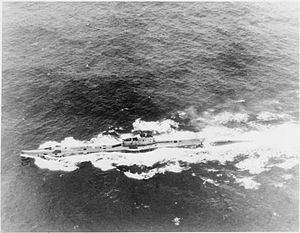Laid down 19 March 1937 Fate sunk 14 January 1942 Construction started 19 March 1937 Length 84 m | Commissioned 2 May 1939 Beam 26 ft 6 in (8.08 m) Launched 16 February 1938 Draft 4.97 m | |
 | ||
Displacement 1,090 tons surfaced1,575 tons submerged Builders Vickers-Armstrongs, Vickers Shipbuilding and Engineering | ||
HMS Triumph (N18) was a T-class submarine of the Royal Navy. She was laid down by Vickers at Barrow-in-Furness and launched in September 1938.
Contents
Career
At the onset of the Second World War, Triumph was a member of the 2nd Submarine Flotilla. From 26-29 August 1939, the flotilla deployed to its war bases at Dundee and Blyth.
Home waters
On 26 December 1939, Triumph hit a German mine in the North Sea. She lost 18 feet (5.5 m) of her bow when it was blown off and her pressure hull was also damaged. Fortunately, the torpedoes in the torpedo tubes did not detonate. She managed to limp back home under the protection of fighter aircraft and destroyers, and was under repair at Chatham Dockyard until 27 September 1940.
Mediterranean
Operating in the Mediterranean from early 1941, Triumph sank the Italian merchants Marzamemi, Colomba Lofaro, Ninfea, Monrosa, the Italian auxiliary patrol vessels V 136 / Tugnin F, Valoroso, V 190 / Frieda and V 137 / Trio Frassinetti, the Italian tug Dante de Lutti and salvage vessel Hercules, the German merchant Luvsee, and the Greek sailing vessels Panagiotis and Aghia Paraskeva. She also damaged the Italian armed merchant cruiser Ramb III, the Italian tankers Ardor and Poseidone, the Italian merchant Sidamo and the German merchant Norburg
In June 1941 she sank the Italian submarine Salpa near northern Egypt.
Sinking
Triumph was also used for covert operations, such as landing agents in German occupied areas. She was planned to be used as a rendezvous for commandos in Operation Colossus, but this had to be cancelled when the landing site became untenable. She undertook one such mission in December 1941, in which she successfully landed agents in Greece. She was lost just over a week later, off Greece, probably to a collision with a mine in early January 1942. All fifty-nine crew were lost.
There is a memorial to her and her lost crew members in All Saint's church, Lindfield, West Sussex.
